Fluid Evolution and Ore Genesis of the Juyuan Tungsten Deposit, Beishan, NW China
Abstract
:1. Introduction
2. Regional Geology
3. Deposit Geology
4. Samples and Analytical Methods
4.1. Fluid Inclusion
4.2. Isotope Analysis
4.3. Muscovite 40Ar/39Ar Dating
5. Fluid Inclusion Geochemistry
5.1. Fluid Inclusion Petrography
5.2. Microthermometry
5.2.1. Early-Stage Fluid Inclusions
5.2.2. Intermediate-Stage Fluid Inclusions
5.2.3. Late-Stage Fluid Inclusions
5.3. Trapping Pressure and Mineralization Depth
5.4. Laser Raman Spectroscopy
6. Isotope Geochemistry
6.1. Hydrogen and Oxygen
6.2. Carbon
6.3. Sulfur
6.4. Lead
6.5. Muscovite 40Ar/39Ar Dating
7. Discussion
7.1. Fluid Nature, Evlution, and Tungsten Deposition
7.2. Timing and Tectonic Setting of Formation of the Juyuan Deposit
8. Conclusions
Author Contributions
Funding
Data Availability Statement
Acknowledgments
Conflicts of Interest
References
- Mao, J.W.; Ouyang, H.G.; Song, S.W.; Santosh, M.; Yuan, S.D.; Zhou, Z.H.; Zheng, W.; Liu, H.; Liu, P.; Cheng, Y.B.; et al. Geology and metallogeny of tungsten and tin deposits in China. SEG Spec. Publ. 2019, 22, 411–482. [Google Scholar]
- Huang, L.C.; Jiang, S.Y. Highly fractionated S-type granites from the giant Dahutang tungsten deposit in Jiangnan Orogen, Southeast China: Geochronology, petrogenesis and their relationship with W mineralization. Lithos 2014, 202–203, 207–226. [Google Scholar] [CrossRef]
- Mao, Z.H.; Liu, J.J.; Mao, J.W.; Deng, J.; Zhang, F.; Meng, X.Y.; Xiong, B.K.; Xiang, X.K.; Luo, X.H. Geochronology and geochemistry of granitoids related to the giant Dahutang tungsten deposit, middle Yangtze River region, China: Implications for petrogenesis, geodynamic setting, and mineralization. Gondwana Res. 2015, 28, 816–836. [Google Scholar] [CrossRef]
- Pan, X.; Hou, Z.; Zhao, M.; Chen, G.; Rao, J.; Li, Y.; Wei, J.; Ouyang, Y. Geochronology and geochemistry of the granites from the Zhuxi W–Cu ore deposit in South China: Implications for petrogenesis, geodynamical setting and mineralization. Lithos 2018, 304–307, 155–179. [Google Scholar] [CrossRef]
- Song, W.L.; Yao, J.M.; Chen, H.Y.; Sun, W.D.; Ding, J.Y.; Xiang, X.K.; Zuo, Q.S.; Lai, C.K. Mineral paragenesis, fluid inclusions, H–O isotopes and ore-forming processes of the giant Dahutang W–Cu–Mo deposit, South China. Ore Geol. Rev. 2018, 99, 116–150. [Google Scholar] [CrossRef]
- Su, Q.W.; Mao, J.W.; Wu, S.H.; Zhang, Z.C.; Xu, S.F. Geochronology and geochemistry of the granitoids and ore-forming age in the Xiaoyao tungsten polymetallic skarn deposit in the Jiangnan Massif tungsten belt, China: Implications for their petrogenesis, geodynamic setting, and mineralization. Lithos 2018, 296–299, 365–381. [Google Scholar] [CrossRef]
- Li, H.; Palinkaš, L.A.; Evans, N.J.; Watanabe, K. Genesis of the Huangshaping W–Mo–Cu–Pb–Zn deposit, South China: Role of magmatic water, metasomatized fluids, and basinal brines during intra-continental extension. Geol. J. 2020, 55, 1409–1430. [Google Scholar] [CrossRef]
- Li, H.; Kong, H.; Guo, B.Y.; Tamehe, L.S.; Zhang, Q.; Wu, Q.H.; Xi, X.S. Fluid inclusion, H–O–S isotope and rare earth element constraints on the mineralization of the Dong’an Sb deposit, South China. Ore Geol. Rev. 2020, 126, 103759. [Google Scholar] [CrossRef]
- Li, H.; Cao, J.; Algeo, T.J.; Jiang, W.; Liu, B.; Wu, Q. Zircons reveal multi-stage genesis of the Xiangdong (Dengfuxian) tungsten deposit, South China. Ore Geol. Rev. 2019, 111, 102979. [Google Scholar] [CrossRef]
- Qin, K.Z.; Fang, T.H.; Wang, S.L.; Zhu, B.Q.; Feng, Y.M.; Yu, H.F.; Xiu, Q.Y. Plate tectonics division, evolution and metallogenic settings in eastern Tianshan mountains, NW China. Xinjiang. Geology 2002, 20, 302–308. (In Chinese) [Google Scholar]
- Zhai, Y.S.; Yao, S.Z.; Cai, K.Q. Mineral Deposits, 3rd ed.; Geological Publishing House: Beijing, China, 2011; pp. 1–280. (In Chinese) [Google Scholar]
- Nie, F.J.; Jiang, S.H.; Hu, P.; Zhang, Y. Geological features and ore-forming material sources of Hongjianbingshan tungsten deposit in Beishan mountains, Gansu province. Min. Depos. 2004, 23, 11–19. (In Chinese) [Google Scholar]
- Jiang, S.H.; Nie, F.J. 40Ar–39Ar geochronology of Hongjianbingshan tungsten deposit in Beishan mountain, Gansu province, China. Min. Depos. 2006, 25, 89–94. (In Chinese) [Google Scholar]
- Ma, D.C.; Xi, Z. The ore-controlling factors of Yushan tungsten deposit. Northwest. Geol. 2012, 45, 57–60. (In Chinese) [Google Scholar]
- Yang, H.Q.; Li, Y.; Zhao, G.B.; Yang, J.G.; Li, W.M.; Yang, L.H. Research results report on prospecting problems in the Beishan metallogenic belt. 2008; 1–321, Unpublished Report. (In Chinese) [Google Scholar]
- Yang, H.Q.; Zhao, G.B.; Li, W.M.; Yang, J.G.; Li, Y.; Wang, X.H.; Jiang, H.B.; Tan, W.J. Formation age and source tracing of the tungsten-bearing granite belt in the Guoqing–Yingzuihongshan area, Inner Mongolia. Geol. Explor. 2010, 46, 353–370. (In Chinese) [Google Scholar]
- Zhang, X.H.; Su, L.; Cui, X.J.; Ding, S.H.; Zhao, J.G.; Chen, L. The age and controlling factors of Yushan tungsten deposit, Beishan Orogen, Gansu Province. Sci. China 2008, 53, 1077. (In Chinese) [Google Scholar]
- Zhao, G.B.; Li, W.M.; Yang, H.Q.; Tian, Y.T.; Quan, S.C.; Qiao, G.B.; Lei, Y.X.; Du, T.; Gao, Y.W.; Yang, T.; et al. Geological and geochemical characteristics of the Guoqing tungsten deposit in Beishan Orogen, Inner Mongolia. Min. Depos. 2010, 29, 341–342. (In Chinese) [Google Scholar]
- Zhao, G.B.; Li, W.M.; Yang, H.Q.; Tian, Y.T.; Gao, Y.W.; Du, T.; Quan, S.C.; Qiao, G.B.; Lei, Y.X.; Yang, T.; et al. Geological and geochemical characteristics of the Guoqing tungsten-bearing granite mass in Inner Mongolia and its genesis. Geol. Explor. 2011, 47, 828–836. (In Chinese) [Google Scholar]
- Zhao, G.B.; Li, W.M.; Yang, H.Q.; Gao, Y.W.; Yang, T.; Jia, J.; Quan, S.C.; Qiao, G.B.; Lei, Y.X. Mineralization and prospecting characteristics of the Guoqing tungsten-bearing granite mass in Inner Mongolia. Northwest. Geol. 2012, 45, 68–71. (In Chinese) [Google Scholar]
- Ding, J.X.; Han, C.M.; Xiao, W.J.; Wang, Z.M.; Yang, X.M. Geochemistry and U–Pb geochronology of tungsten deposit of Huaniushan island arc in the Beishan Orogenic Belt, and its geodynamic background. Acta Petrol. Sin. 2015, 31, 594–616. (In Chinese) [Google Scholar]
- Cao, J.; Xia, D.; Zheng, J.; Sun, Y.; Liu, Y.; Liu, Y. Geological characteristics of Juyuan gold–tungsten polymetallic deposit in Hami, Xinjiang. Xinjiang Geol. Surv. 2020, 38, 203–205. [Google Scholar]
- Sun, J.G.; Hu, S.X.; Shen, K.; Yao, F.L. Research on C, O isotopic geochemistry of intermediate–basic and intermediate–acid dykes in gold fields of Jiaodong Peninsula. Acta Petrol. Mineral. 2001, 30, 47–56. [Google Scholar]
- Sengör, A.M.C.; Natalin, B.A.; Buttman, U.S. Evolution of the Altaid tectonic collage and Paleozoic crustal growth in Eurasia. Nature 1993, 364, 299–307. [Google Scholar] [CrossRef]
- Jahn, B.M.; Wu, F.Y.; Chen, B. Massive granitoid generation in central Asia: Nd isotopic evidence and implication for continental growth in the Phanerozoic. Episodes 2000, 23, 82–92. [Google Scholar] [CrossRef] [Green Version]
- Windley, B.F.; Alexeiev, D.; Xiao, W.; Kröner, A.; Badarch, G. Tectonic models for accretion of the Central Asian Orogenic Belt. J. Geol. Soc. 2007, 164, 31–47. [Google Scholar] [CrossRef] [Green Version]
- Xiao, W.J.; Mao, Q.G.; Windley, B.F.; Han, C.M.; Qu, J.F.; Zhang, J.E.; Ao, S.J.; Guo, Q.Q.; Cleven, N.T.; Lin, S.F. Paleozoic multiple accretionary and collisional processes of the Beishan orogenic collage. Am. J. Sci. 2010, 310, 1553–1594. [Google Scholar] [CrossRef]
- Tian, Z.H.; Xiao, W.J.; Shan, Y.H.; Windley, B.; Han, C.M.; Zhang, J.E.; Wan, B.; Ao, S.J.; Song, D.F.; Feng, J.Y. Structures, ages and tectonic development of the Huoshishan–Niujuanzi ophiolitic mélange, Beishan, southernmost Altaids. Gondwana Res. 2014, 25, 820–841. [Google Scholar] [CrossRef]
- Xiao, W.J.; Santosh, M. The western Central Asian orogenic belt: A window to accretionary orogenesis and continental growth. Gondwana Res. 2014, 25, 1429–1444. [Google Scholar] [CrossRef]
- Li, P. Geological Characteristics and Genesis of Hongjianbingshan Tungsten Deposit, Beishan Mountain, Gansu Province. Master’s Thesis, China University of Geosciences, Wuhan, China, 2011; pp. 1–127. (In Chinese). [Google Scholar]
- Mao, Q.G. Paleozoic to Early Mesozoic Accretionary and Collisional Tectonics of the Beishan and Adjacent Area, Northwest China. Ph.D. Thesis, Institute of Geology and Geophysics, Chinese Academy of Sciences, Beijing, China, 2008; pp. 1–228. (In Chinese). [Google Scholar]
- Guo, Q.Q.; Xiao, W.J.; Windley, B.F.; Mao, Q.G.; Han, C.M.; Qu, J.F.; Ao, S.J.; Li, J.L.; Song, D.F.; Yong, Y. Provenance and tectonic settings of Permian turbidites from the Beishan Mountains, NW China: Implications for the Late Paleozoic accretionary tectonics of the southern Altaids. J. Asian Earth Sci. 2012, 49, 54–68. [Google Scholar] [CrossRef]
- Tian, Z.H.; Xiao, W.J.; Shan, Y.H.; Windley, B.; Han, C.M.; Zhang, J.E.; Song, D.F. Mega-fold interference patterns in the Beishan orogen (NW China) created by change in plate configuration during Permo-Triassic termination of the Altaids. J. Struct. Geol. 2013, 52, 119–135. [Google Scholar] [CrossRef]
- Yang, H.Q.; Li, Y.; Li, W.M.; Yang, J.G.; Zhao, G.B.; Sun, N.Y.; Wang, X.H.; Tan, W.J. General discussion on metallogenetic tectonic setting of Beishan Mountain, northwestern China. Northwest. Geol. 2008, 41, 22–28. (In Chinese) [Google Scholar]
- Li, P.; Lv, X.B.; Chen, C.; Cao, X.F.; Mayila, A.; Su, Y.Y. Chronology and geochemical characteristics of K-feldspar granite in the Guoqing tungsten deposit and their geological implications. Acta Petrol. Mineral. 2011, 30, 13–24. (In Chinese) [Google Scholar]
- Nie, F.J.; Jiang, S.H.; Zhao, S.M.; Bai, D.M.; Liu, Y.; Zhao, Y.M.; Wang, X.L.; Su, X.X. Geological characteristics and types of Liushashan Au (Mo) deposit, Inner Mongolia. Geol. Geochem. 2002, 30, 1–7. (In Chinese) [Google Scholar]
- Nie, F.J.; Jiang, S.H.; Bai, D.M.; Zhang, Y.; Zhao, Y.M.; Wang, X.L. Type and temporal–spatial distribution of metal deposits in the Beishan Mountains, Inner Mongolia and its Neighboring Region. Acta Geol. Sin. 2003, 77, 367–378. (In Chinese) [Google Scholar]
- Li, H.Q.; Chen, F.W. Isotope Geochronology of Regional Mineralization in Xinjiang, NW China; Geological Publishing House: Beijing, China, 2004; pp. 1–391. (In Chinese) [Google Scholar]
- Li, H.Q.; Wu, H.; Chen, F.W.; Deng, G.; Yang, H.M.; Yang, Z.F.; Mei, Y.P.; Guo, J. New chronological evidence for Indosinian diagenetic mineralization in eastern Xinjiang, NW China. Acta Geol. Sin. 2005, 79, 264–275. (In Chinese) [Google Scholar]
- Li, N.; Yang, F.Q.; Zhang, Z.X.; Yang, C.D. Geochemistry and chronology of the biotite granite in the Xiaobaishitou W–(Mo) deposit, eastern Tianshan, China: Petrogenesis and tectonic implications. Ore Geol. Rev. 2019, 107, 999–1019. [Google Scholar] [CrossRef]
- Bodnar, R.J. Revised equation and table for determining the freezing point depression of H2O–NaCl solutions. Geochim. Cosmochim. Acta 1993, 57, 683–684. [Google Scholar] [CrossRef]
- Collins, P.L.F. Gas hydrates in CO2-bearing fluid inclusions and use of freezing data for estimation of salinity. Econ. Geol. 1979, 74, 1435–1444. [Google Scholar] [CrossRef]
- Robert, S.D. An extended equation to calculate NaCl contents from final clathrate melting temperatures in H2O-CO2-NaCl fluid inclusions: Implications for P-T isochore location. Geochim. Cosmochim. Acta 1991, 55, 3869–3871. [Google Scholar]
- Bowers, T.S.; Helgeson, H.C. Calculation of the thermodynamic and geochemical consequences of nonideal mixing in the system H2O-CO2-NaCl on phase relations in geological systems:Equation of statemperature for H2O-CO2-NaCl fluids at high pressures and temperatures. Geochim. Cosmochim. Acta 1983, 47, 1247–1275. [Google Scholar] [CrossRef]
- Brown, P.E.; Lamb, W.M. P–V–T properties of fluids in the system H2O–CO2–NaCl: New graphical presentations and implications for fluid inclusion studies. Geochim. Cosmochim. Acta 1989, 53, 1209–1221. [Google Scholar] [CrossRef]
- Ding, T.; Jiang, S.; Wan, D.; Li, Y.; Li, J.; Song, H.; Liu, Z.; Yao, X. Silicon Isotope Geochemistry; Geological Publishing House: Beijing, China, 1996; pp. 1–122. [Google Scholar]
- Clayton, R.N.; O’Neil, J.R.; Mayeda, T.K. Oxygen isotope exchange between quartz and water. J. Geophys. Res. 1972, 77, 3057–3067. [Google Scholar] [CrossRef]
- Sang, H.Q.; Wang, F.; He, H.Y.; Wang, Y.L.; Yang, L.K.; Zhu, R.X. Intercalibration of ZBH-25 biotite reference material utilized for K–Ar and 40Ar–39Ar age determination. Acta Petrol. Sin. 2006, 22, 3059–3078. [Google Scholar]
- Nier, A.O. A redetermination of the relative abundances of isotopes of carbon, nitrogen, oxygen, argon and potassium. Phys. Rev. 1950, 77, 789–793. [Google Scholar] [CrossRef]
- Steiger, R.H.; Jäger, E. Subcommission on geochronology: Convention on the use of decay constants in geo- and cosmochronology. Earth Planet. Sci. Lett. 1977, 36, 359–362. [Google Scholar] [CrossRef]
- Koppers, A.A.P. Ar-Ar CALC-software for 40Ar/39Ar age calculations. Comput. Geosci. 2002, 28, 605–619. [Google Scholar] [CrossRef]
- Roedder, E. Fluid inclusions. Rev. Mineral. 1984, 12, 1–644. [Google Scholar]
- Zhou, Z.-J.; Chen, Y.-J.; Jiang, S.-Y.; Hu, C.-J.; Qin, Y.; Zhao, H.-X. Isotope and fluid inclusion geochemistry and genesis of the Qiangma gold deposit, Xiaoqinling gold field, Qinling Orogen, China. Ore Geol. Rev. 2015, 66, 47–64. [Google Scholar] [CrossRef]
- Taylor, H.P. Oxygen and hydrogen isotope relationships in hydrothermal mineral deposits. In Geochemistry of Hydrothermal Ore Deposits; Barnes, H.L., Ed.; John Wiley and Sons: New York, NY, USA, 1997; pp. 229–302. [Google Scholar]
- Schwinn, G.; Wagner, T.; Baatartsogt, B.; Markl, G. Quantification of mixing processes in ore-forming hydrothermal systems by combination of stable isotope and fluid inclusion analyses. Geochim. Cosmochim. Acta 2006, 70, 965–982. [Google Scholar] [CrossRef]
- Hoefs, J. Stable Isotope Geochemistry, 3rd ed.; Springer: Berlin/Heidelberg, Germany, 1997; pp. 1–250. [Google Scholar]
- Faure, G. Principles of Isotope Geology, 2nd ed.; John Wiley and Sons: New York, NY, USA, 1986; pp. 1–608. [Google Scholar]
- Nelson, D.R.; Chivas, A.R.; Chappell, B.W.; McCulloch, M.T. Geochemical and isotopic systematics in carbonatites and implications for the evolution of ocean-island sources. Geochim. Cosmochim. Acta 1998, 52, 1–17. [Google Scholar] [CrossRef]
- Liu, J.M.; Liu, J.J. Basin fluid genetic model of sediment-hosted micro-disseminated gold deposits in the gold-triangle area between Guizhou, Guangxi and Yunnan. Acta Mineral. Sin. 1997, 17, 448–456. (In Chinese) [Google Scholar]
- Ray, J.S.; Ramesh, R.; Pande, K.; Trivedi, J.R.; Shukla, P.N.; Patel, P.P. Isotope and rare earth element chemistry of carbonatite–alkaline complexes of Deccan volcanic province: Implications to magmatic and alteration processes. J. Asian Earth Sci. 2000, 18, 177–194. [Google Scholar] [CrossRef]
- Liu, J.J.; He, M.Q.; Li, Z.M.; Liu, Y.P.; Li, C.Y.; Zhang, Q.; Yang, W.G.; Yang, A.P. Oxygen and carbon isotopic geochemistry of Baiyangping silver–copper polymetallic ore concentration area in Lanping Basin of Yunnan Province and its significance. Miner. Depos. 2004, 23, 1–10. (In Chinese) [Google Scholar]
- Hoefs, J. Stable Isotope Geochemistry, 7th ed.; Springer: Berlin/Heidelberg, Germany, 2015; pp. 1–389. [Google Scholar]
- Ohmoto, H.; Goldhaber, M.B. Sulphur and carbon isotopes. In Geochemistry of Hydrothermal Ore Deposits; Barnes, H.L., Ed.; John Wiley and Sons: New York, NY, USA, 1997; pp. 517–612. [Google Scholar]
- Jin, C.H.; Li, K.; Huang, L.; Zhang, Y.; Shen, Z.W. Characteristics of sulfur and lead isotope composition and metallogenic material source of the Nayongzhi Pb–Zn deposit, northwestern Guizhou Province. J. Mineral. Petrol. 2015, 35, 81–88. [Google Scholar]
- LaFlamme, C.; Sugiono, D.; Thebaud, N.; Caruso, S.; Fiorentini, M.; Selvaraja, V.; Jeon, H.; Voute, F.; Martin, L. Multiple sulfur isotopes monitor fluid evolution of an Archean orogenic gold deposit. Geochim. Cosmochim. Acta 2018, 222, 436–446. [Google Scholar] [CrossRef]
- Peng, N.J.; Jiang, S.Y.; Xiong, S.F.; Pi, D.H. Fluid evolution and ore genesis of the Dalingshang deposit, Dahutang W–Cu ore field, northern Jiangxi Province, South China. Miner. Depos. 2018, 53, 1079–1094. [Google Scholar] [CrossRef]
- Tsang, H.Y.; Cao, J.Y.; Yang, X.Y. Source of the Chaoyangzhai gold deposit, Southeast Guizhou: Constraints from LA–ICP–MS zircon U–Pb dating, whole-rock geochemistry and in situ sulfur isotopes. Minerals 2019, 9, 235. [Google Scholar] [CrossRef] [Green Version]
- Zheng, Y.; Chen, J. Stable Isotope Geochemistry; Science Press: Beijing, China, 2000; pp. 1–316. [Google Scholar]
- Ohmoto, H.; Rye, R.O. Isotopes of sulfur and carbon. In Geochemistry of Hydrothermal Ore Deposits, 2nd ed.; Barnes, H.L., Ed.; John Wiley and Sons: New York, NY, USA, 1979; pp. 509–567. [Google Scholar]
- Zartman, R.E.; Doe, B.R. Plumbotectonics—The model. Tectonophysics 1981, 75, 135–162. [Google Scholar] [CrossRef]
- Fan, H.R.; Xie, Y.H.; Zhao, R.; Wang, Y.L. Dual origins of Xiaoqinling gold-bearing quartz veins: Fluid inclusion evidences. Chin. Sci. Bull. 2000, 45, 1424–1430. [Google Scholar] [CrossRef]
- Fan, H.R.; Xie, Y.H.; Zhai, M.G.; Jin, C.W. A three stages fluid flow model for Xiaoqinling lode gold metallogenesis in the Henan and Shaanxi provinces, central China. Acta Petrol. Sin. 2003, 19, 260–266. (In Chinese) [Google Scholar]
- Hagemann, S.G.; Luders, V. P–T–X conditions of hydrothermal fluids and precipitation mechanism of stibnite–gold mineralization at the Wiluna lode-gold deposits, Western Australia: Conventional and infrared microthermometric constraints. Miner. Depos. 2003, 38, 936–952. [Google Scholar] [CrossRef]
- Coulibaly, Y.; Boiron, M.C.; Cathelineau, M.; Kouamelan, A.N. Fluid immiscibility and gold deposition in the Birimian quartz veins of the Angovia deposit (Yaoure, Ivory Coast). J. Afr. Earth Sci. 2008, 50, 234–254. [Google Scholar] [CrossRef]
- Chi, G.; Lu, H. Validation and representation of fluid inclusion microthermometric data using the fluid inclusion assemblage (FIA) concept. Acta Petrol. Sin. 2008, 24, 1945–1953. [Google Scholar]
- Shmulovich, K.I.; Landwehr, D.; Simon, K.; Heinrich, W. Stable isotope fractionation between liquid and vapour in water–salt systems up to 600 °C. Chem. Geol. 1999, 157, 343–354. [Google Scholar] [CrossRef]
- Driesner, T.; Seward, T.M. Experimental and simulation study of salt effects and pressure/density effects on oxygen and hydrogen stable isotope liquid–vapor fractionation for 4–5 molal aqueous NaCl and KCl solutions to 400 °C. Geochim. Cosmochim. Acta 2000, 64, 1773–1784. [Google Scholar] [CrossRef]
- Zhu, J.; Lü, X.B.; Cao, X.F.; Mo, Y.; Chen, C. U–Pb zircon geochronology, geochemistry and kinetics of the Huaniushan A-type granite in Northwest China. Chin. J. Geochem. 2012, 31, 85–94. [Google Scholar] [CrossRef]
- Ding, J.X.; Han, C.M.; Xiao, W.J.; Wang, Z.M.; Song, D.F. Geochronology, geochemistry and Sr-Nd isotopes of the granitic rocks associated with tungsten deposits in Beishan district, NW China, Central Asian Orogenic Belt: Petrogenesis, metallogenic and tectonic implications. Ore Geol. Rev. 2017, 89, 441–462. [Google Scholar] [CrossRef]
- Laurent-Charvet, S.; Charvet, J.; Monie, P.; Shu, L. Late Paleozoic strike-slip shear zones in eastern central Asia (NW China): New structural and geochronological data. Tectonics 2003, 22, 1009. [Google Scholar] [CrossRef] [Green Version]
- Lamb, M.A.; Badarch, G.; Navratil, T.; Poier, R. Structural and geochronologic data from the Shin Jinst area, eastern Gobi Altai, Mongolia: Implications for Phanerozoic intracontinental deformation in Asia. Tectonophysics 2008, 451, 312–330. [Google Scholar] [CrossRef]
- Wang, T.; Jahn, B.M.; Kovach, V.P.; Tong, Y. Mesozoic anorogenic granitic magmatism in the Altai Paleozoic accretionary orogen, NW China: Implications for crustal architecture and growth. Am. J. Sci. 2014, 314, 1–42. [Google Scholar] [CrossRef]
- Wang, Y.; Sun, G.; Li, J. U–Pb (SHRIMP) and 40Ar/39Ar geochronological constraints on the evolution of the Xingxingxia shear zone, NW China: A Triassic segment of the Altyn Tagh fault system. Geol. Soc. Am. Bull. 2010, 122, 487–505. [Google Scholar] [CrossRef]
- Xiao, W.J.; Windley, B.F.; Huang, B.C.; Han, C.M.; Yuan, C.; Chen, H.L.; Sun, M.; Sun, S.; Li, J.L. End-Permian to mid-Triassic termination of the accretionary processes of the southern Altaids: Implications for the geodynamic evolution, Phanerozoic continental growth, and metallogeny of Central Asia. Int. J. Earth Sci. 2009, 98, 1189–1287. [Google Scholar] [CrossRef]
- Ye, D.J.; Zhan, J.B.; Liang, M.H.; Xiao, L. Formational and Tectonic Map of the Mazongshan Region, Gansu, China, 1:250,000; Institute of Geological Survey: Lanzhou, China, 2008. [Google Scholar]
- Xiao, W.J.; Huang, B.C.; Han, C.M.; Sun, S.; Li, J.L. A review of the western part of the Altaids: A key to understanding the architecture of accretionary orogens. Gondwana Res. 2010, 18, 253–273. [Google Scholar] [CrossRef]
- Wu, F.Y.; Sun, D.Y.; Ge, W.C.; Zhang, Y.B.; Grant, M.L.; Wilde, S.A.; Jahn, B.M. Geochronology of the Phanerozoic granitoids in northeastern China. J. Asian Earth Sci. 2011, 41, 1–30. [Google Scholar] [CrossRef] [Green Version]
- Li, N.; Yang, F.; Zhang, Z. Fluid inclusions and isotope (C, H, O, S, He, and Ar) study of the Xiaobaishitou skarn W–(Mo) deposit, East Tianshan, NW China. Ore Geol. Rev. 2020, 122, 103520. [Google Scholar] [CrossRef]
- Pirajno, F.; Ernst, R.E.; Borisenko, A.S.; Fedoseev, G.; Naumov, E. Intraplate magmatism in Central Asia and China and associated metallogeny. Ore Geol. Rev. 2009, 35, 114–136. [Google Scholar] [CrossRef]
- Chappell, B.W. Aluminium saturation in I- and S-type granites and the characterization of fractionated hapogranites. Lithos 1999, 46, 535–551. [Google Scholar] [CrossRef]
- Chappell, B.W.; White, A.J.R. I- and S-type granites in the Lachlan Fold Belt. Trans. R. Soc. Edinb. Earth Sci. 1992, 83, 1–26. [Google Scholar]
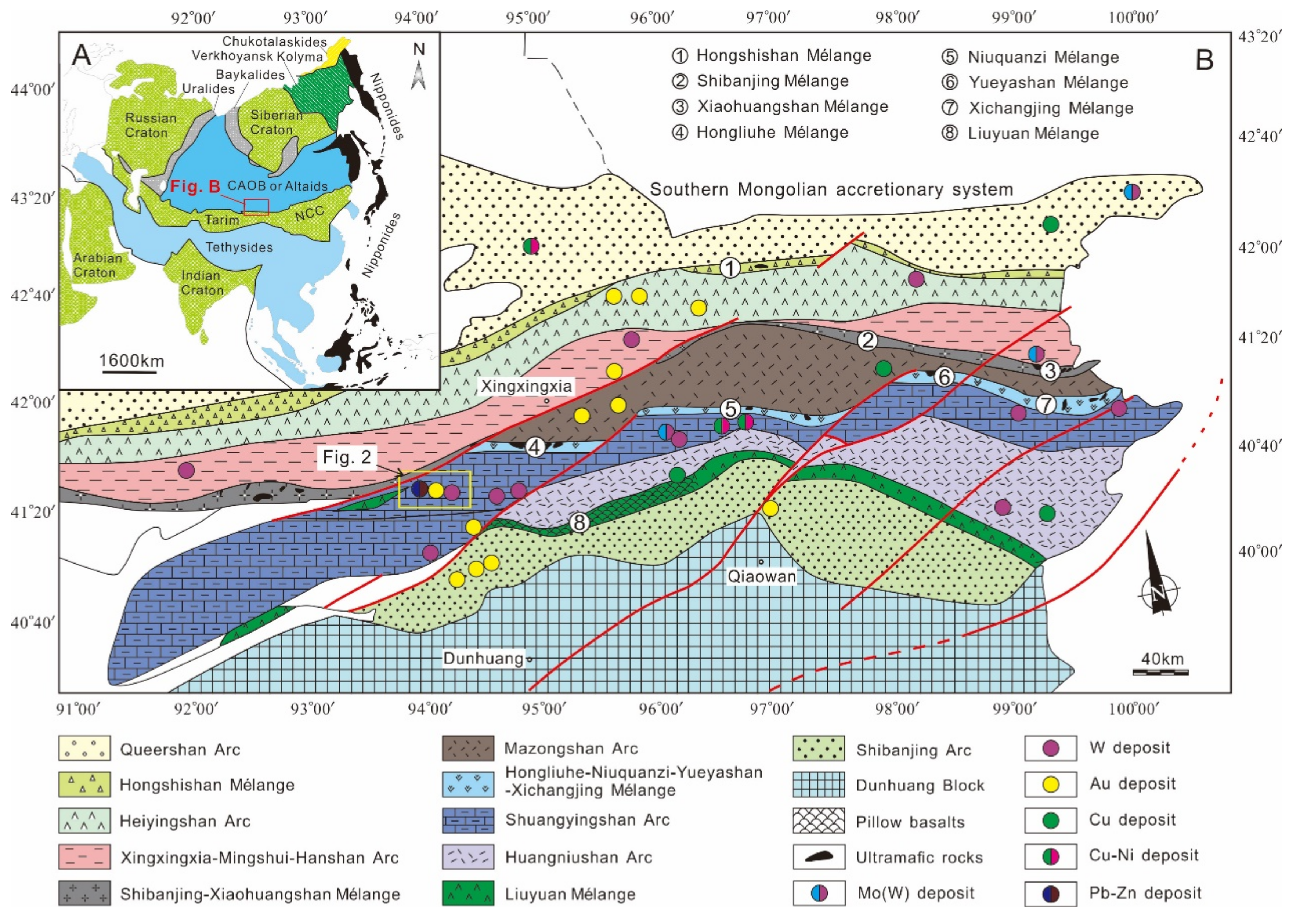
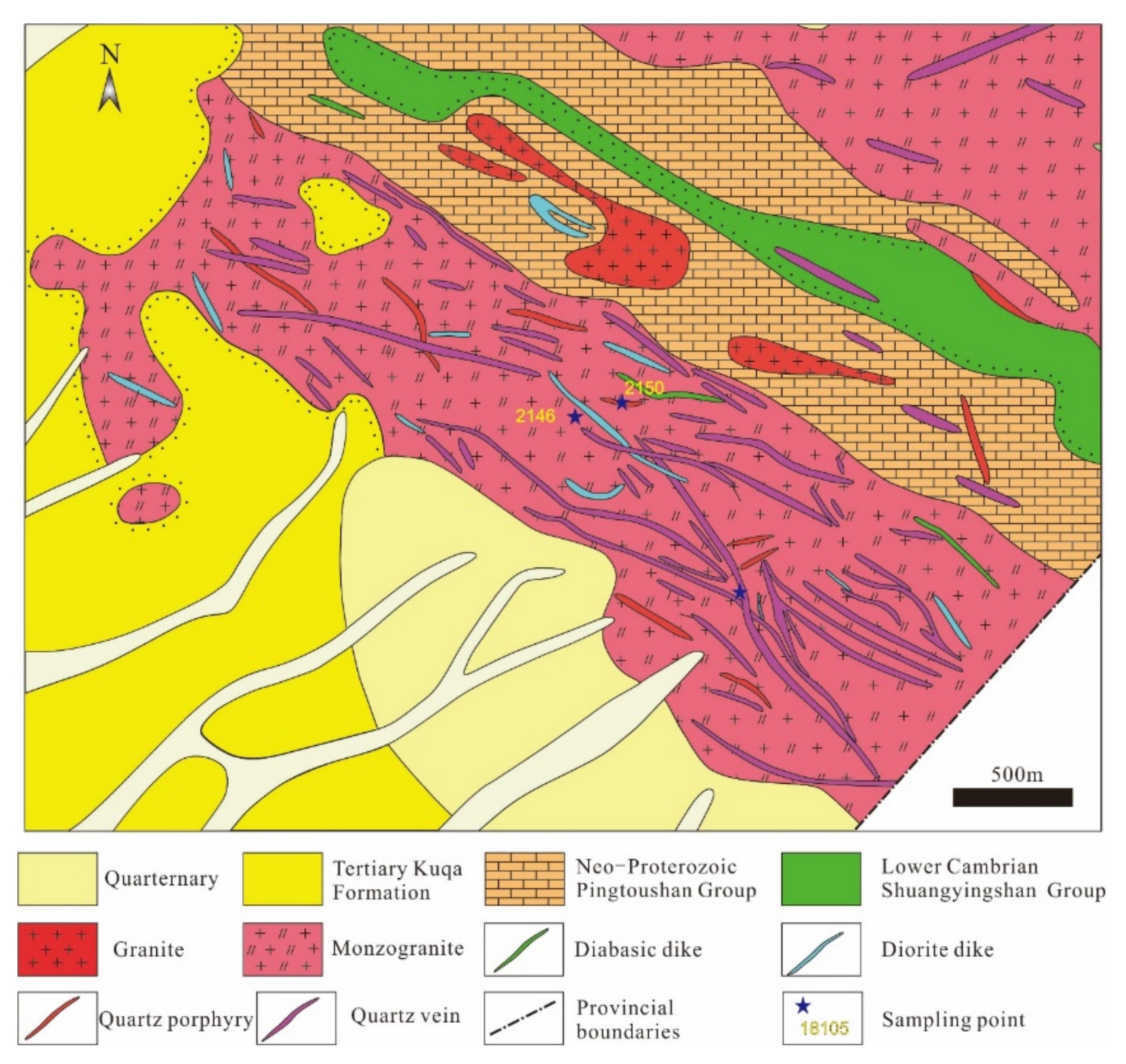
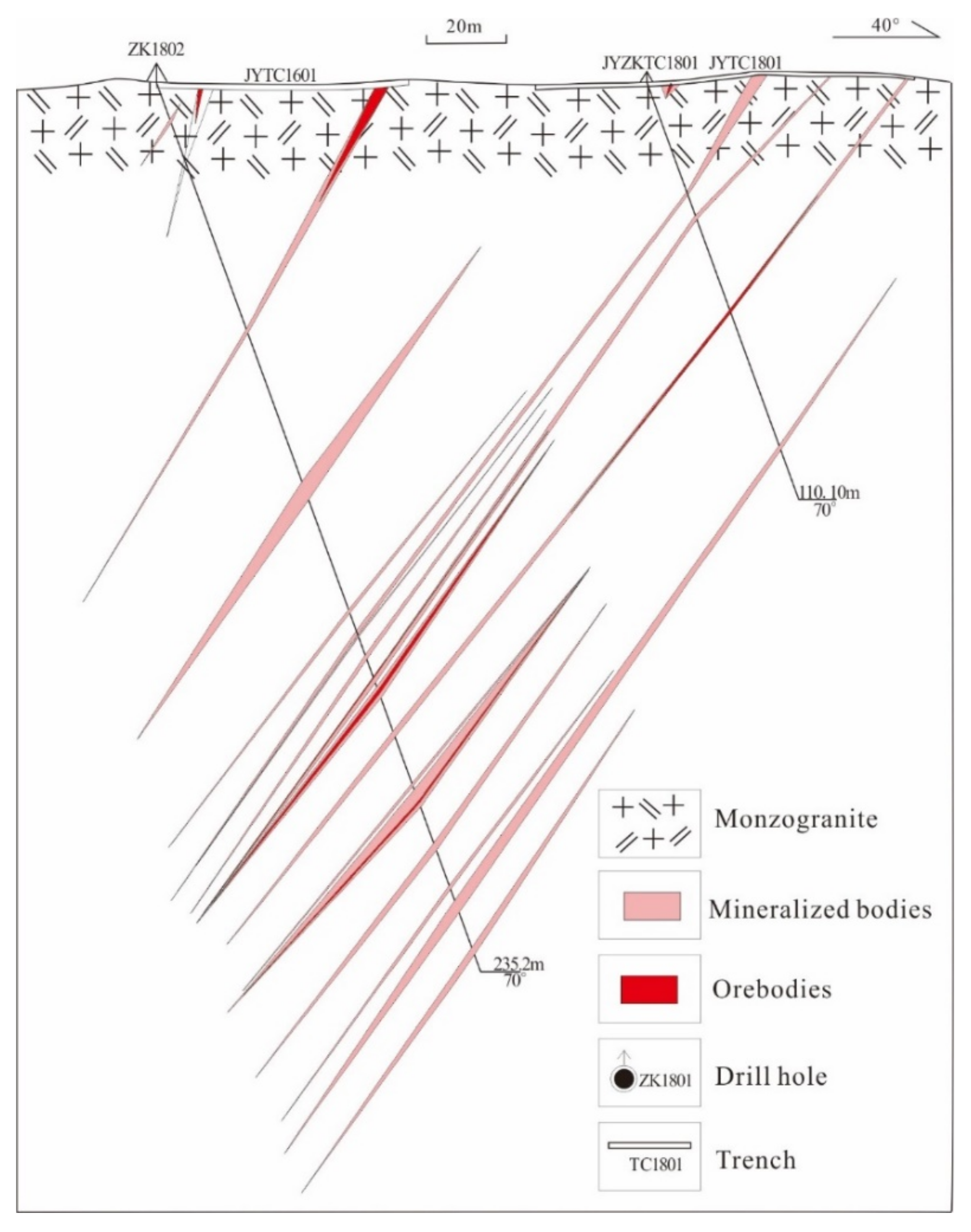
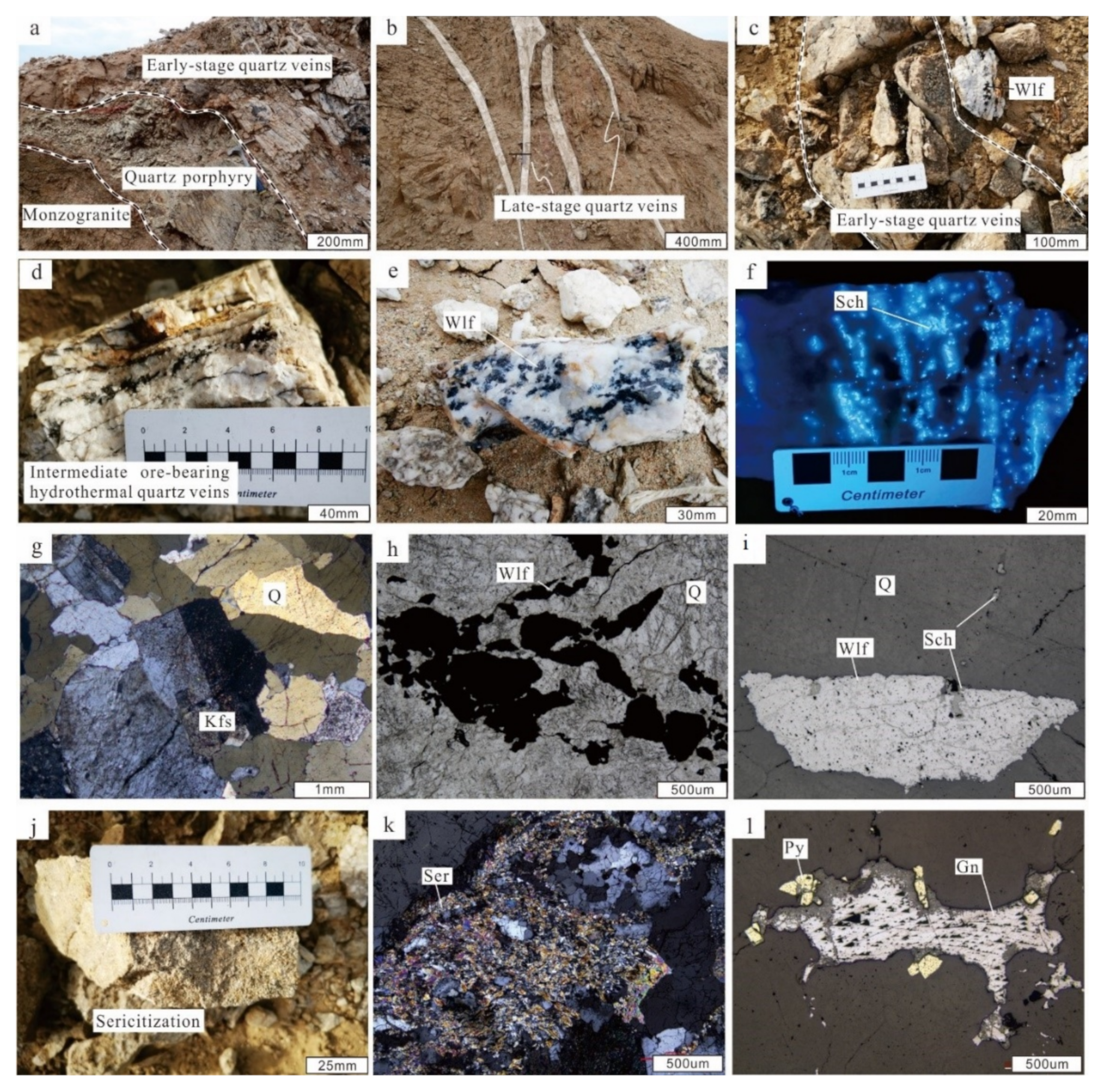


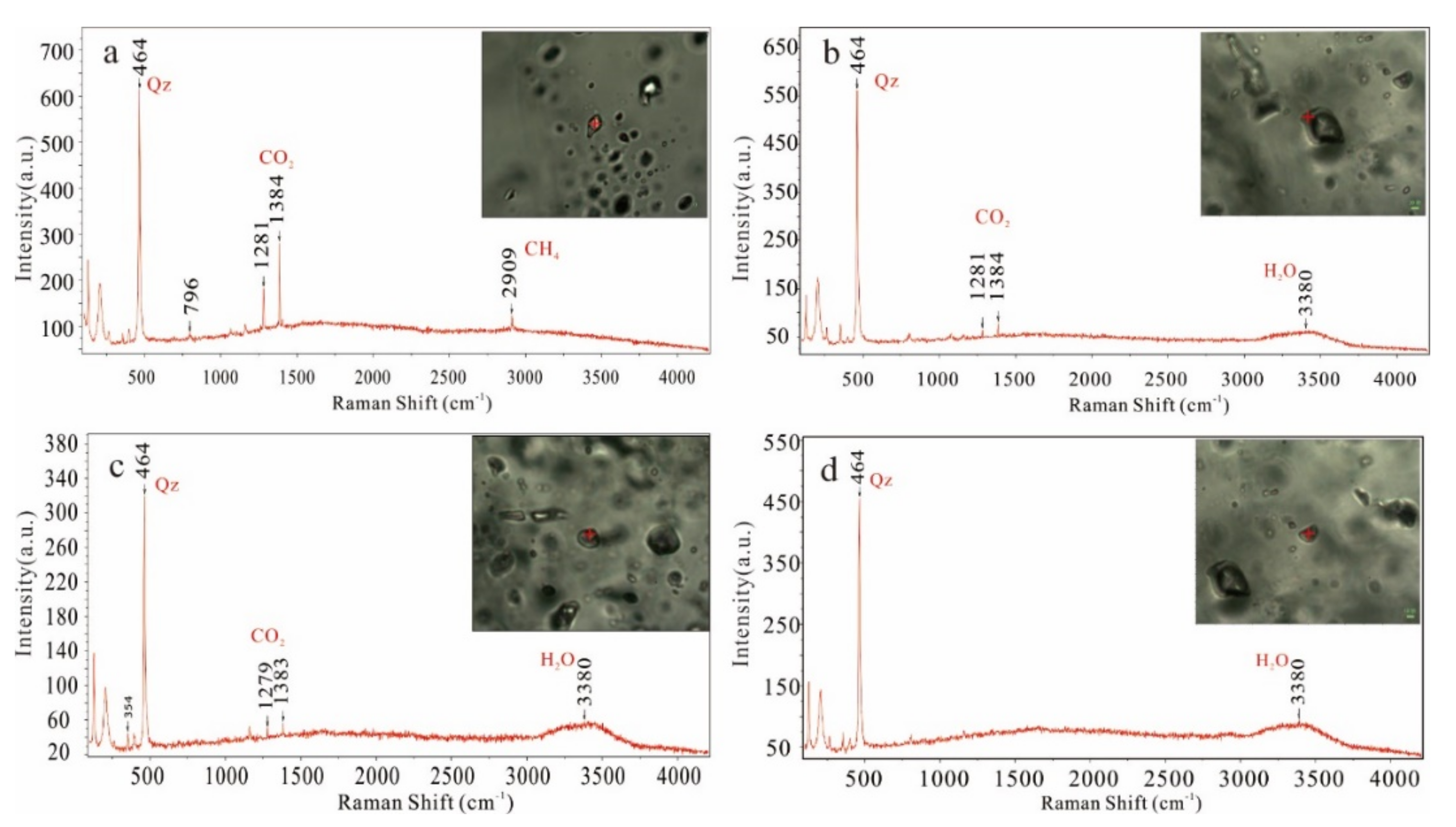
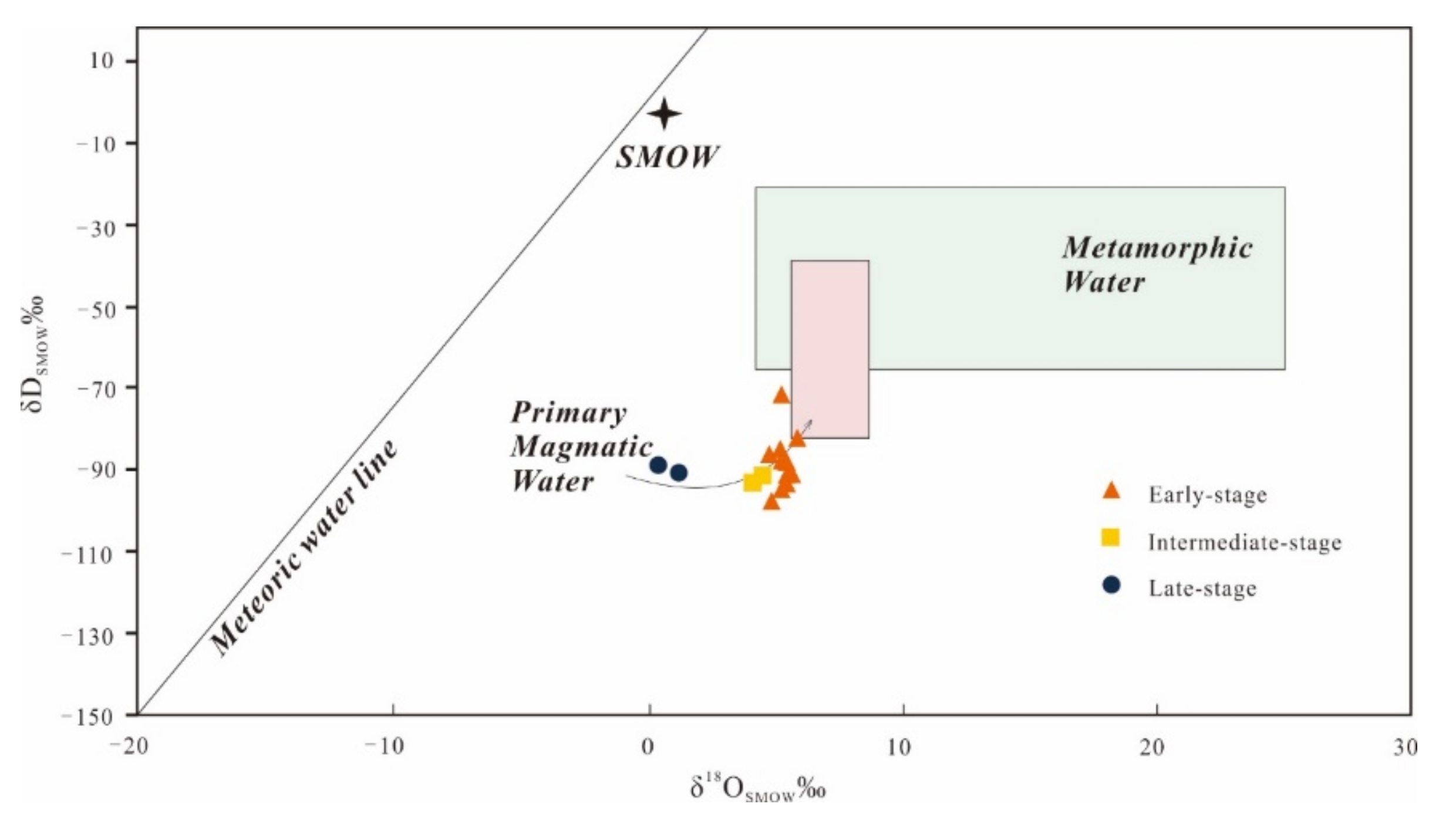
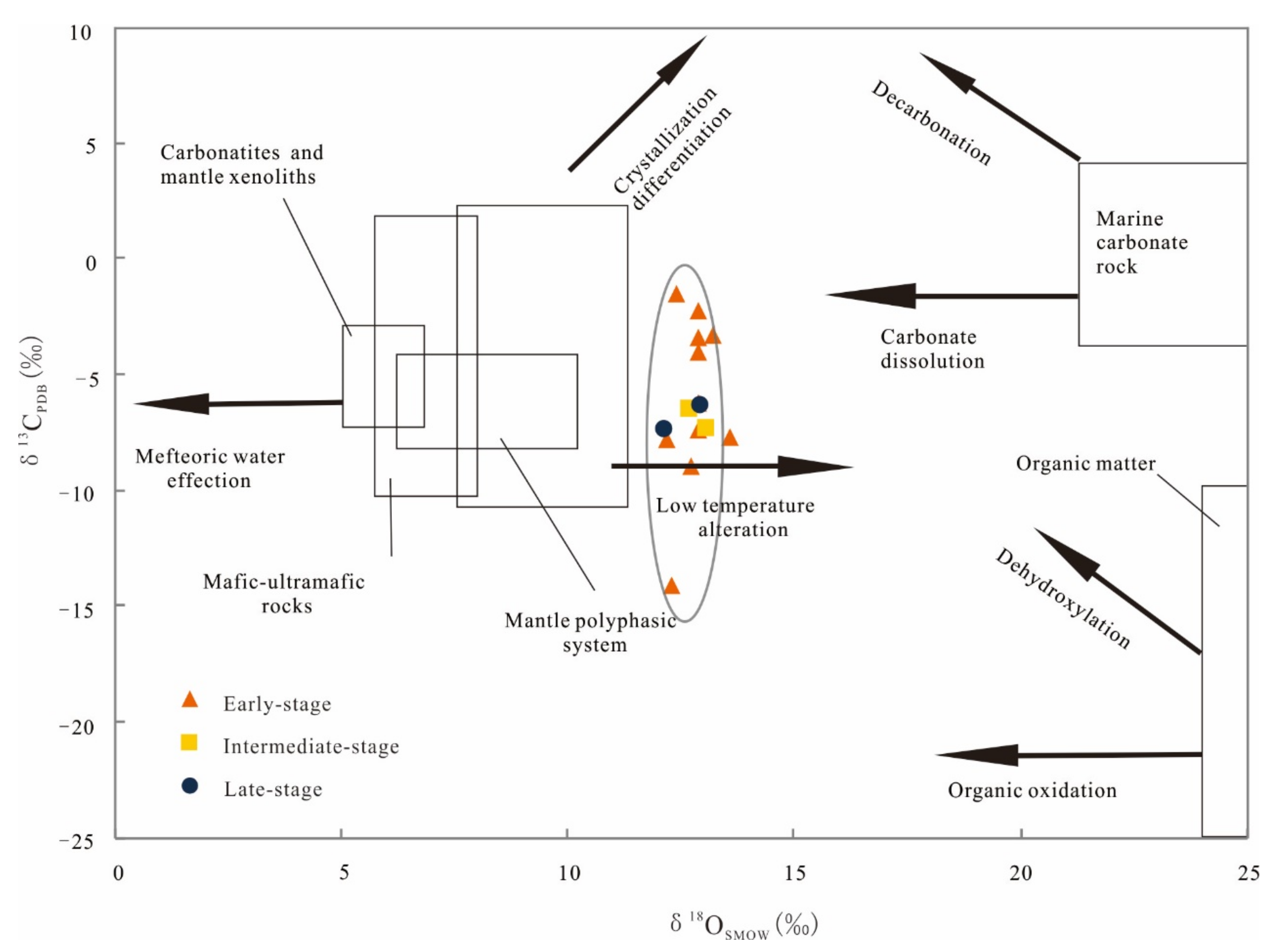
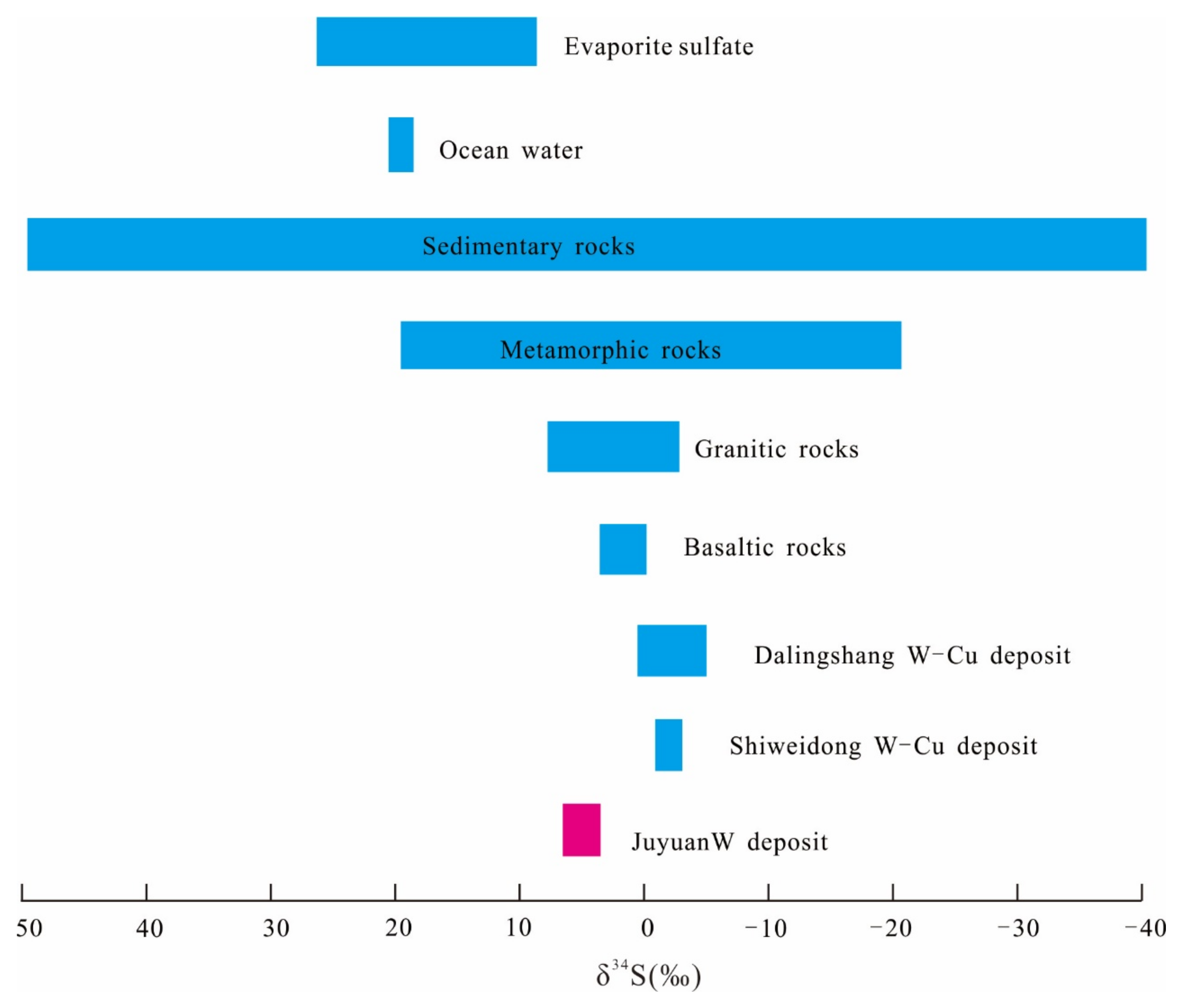
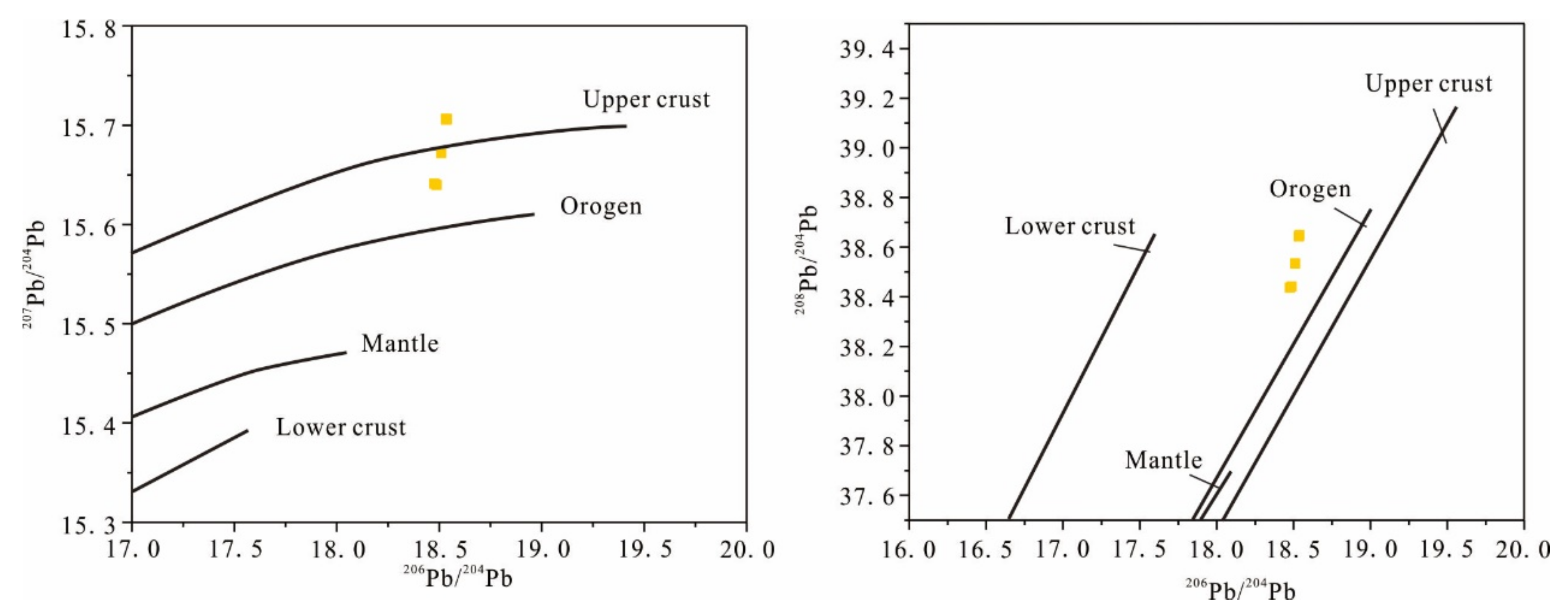


| Stage | Sample No. | Type | Number | Size (μm) | Vapor (vol.%) | Tm-CO2 (°C) | Tm-cl (°C) | Th-CO2 (°C) | Tm-ice (°C) | Th-tot (°C) | Salinity (wt.% NaCl equiv.) | CO2 Density (g/cm3) | Bulk Density (g/cm3) |
|---|---|---|---|---|---|---|---|---|---|---|---|---|---|
| Early | D1936-1 | C | 13 | 5–9 | 25–85 | −60.9 to −68.8 | 5.4–8.3 | 26.9–31.1 (L/V) | 261–343 (L/V) | 3.3–8.4 | 0.54–0.69 | 0.69–0.92 | |
| PC | 2 | 5–7 | 20–30 | −62.5 to −63.2 | 5.4–8.3 | 28.3–29.1 (L) | 0.63–0.65 | ||||||
| D1938-3a | C | 12 | 6–27 | 15–50 | −58.2 to −69.6 | 6.2–8.7 | 27.0–31.1 (L) | 266–327 (L) | 2.6–7.1 | 0.59–0.69 | 0.83–0.95 | ||
| W | 2 | 6–9 | 20–30 | −2.8 to −5.8 | 275–282 (L) | 4.7–9.0 | |||||||
| S | 1 | 15 | 15 | −6.8 | 246 (L) | 10.2 | |||||||
| D1958-2-2 | C | 8 | 4–12 | 20–75 | −59.0 to −67.1 | 4.4–8.6 | 17.2–29.6 (L/V) | 253–318 (L/V) | 2.8–9.9 | 0.65–0.81 | 0.79–0.97 | ||
| PC | 1 | 6 | 40 | −60.2 | 26.5 (L) | 0.69 | |||||||
| D1958-4a | C | 2 | 5–7 | 15–20 | −61.0 to −61.9 | 6.0–6.7 | 28.0–30.6 (L) | 249–321 (L) | 6.2–7.4 | 0.62–0.68 | 0.95–0.99 | ||
| D1965-1 | C | 17 | 6–11 | 25–95 | −58.2 to −66.7 | 6.0–8.7 | 28.8–31.1 (L/V) | 249–333 (L/V) | 2.6–7.4 | 0.52–0.64 | 0.69–0.92 | ||
| D1966-1 | C | 11 | 5–10 | 15–45 | −60.5 to −67.0 | 7.2–10.0 | 27.2–30.7 (L) | 265–336 (L) | 0.02–5.3 | 0.62–0.70 | 0.83–0.97 | ||
| W | 1 | 7 | 15 | −5.5 | 280 (L) | 8.6 | |||||||
| D1967-1 | C | 19 | 4–9 | 15–90 | −59.8 to −63.9 | 5.5–8.5 | 26.1–30.6 (L/V) | 240–340 (L/V) | 3.0–8.2 | 0.62–0.71 | 0.71–0.96 | ||
| PC | 2 | 5–7 | 25–30 | −61.9 to −62.6 | 15.9–25.7 (L) | 0.70–0.81 | |||||||
| D2016-1 | C | 8 | 5–9 | 30–40 | −56.7 to −62.7 | 6.1–9.7 | 24.5–30.4 (L) | 248–290 (L) | 0.6–7.2 | 0.62–0.74 | 0.86–0.95 | ||
| D2017-1 | C | 5 | 5–7 | 30–35 | −57.4 to −64.3 | 6.9–8.8 | 29.7–30.8 (L) | 260–324 (L) | 2.4–5.9 | 0.61–0.67 | 0.88–0.92 | ||
| W | 1 | 5 | 30 | −6.5 | 232 (L) | 9.9 | |||||||
| D2022-1 | C | 6 | 5–6 | 30–40 | −56.7 to −59.7 | 6.9–9.2 | 27.7–29.8 (L) | 241–340 (L) | 1.6–5.9 | 0.64–0.69 | 0.87–0.91 | ||
| W | 2 | 5–6 | 35–40 | −3.1 to −7.4 | 230–278 (L) | 5.1–11 | |||||||
| D2032-1 | C | 7 | 5–7 | 25–40 | −58.0 to −64.7 | 6.8–9.7 | 29.5–31.0 (L) | 257–338 (L) | 0.6–6.0 | 0.60–0.67 | 0.86–0.92 | ||
| D2033-1 | C | 32 | 5–11 | 20–40 | −56.9 to −67.3 | 4.0–9.3 | 25.8–31.0 (L) | 230–309 (L) | 1.4–10.5 | 0.60–0.72 | 0.84–0.96 | ||
| W | 1 | 10 | 15 | −5.8 | 264 (L) | 9.0 | |||||||
| D2045-1 | C | 10 | 5–11 | 30–45 | −57.1 to −63.1 | 8.6–10.0 | 28.9–30.8 (L) | 275–334 (L) | 0.02–2.77 | 0.61–0.66 | 0.83–0.90 | ||
| D2048-1 | C | 8 | 5–8 | 30–45 | −57.2 to −65.4 | 6.7–9.3 | 25.7–30.9 (L) | 257–344 (L) | 1.4–6.2 | 0.61–0.65 | 0.85–0.90 | ||
| Intermediate | D1935-1 | C | 8 | 5–13 | 15–40 | −58.8 to −68.7 | 7.4–8.5 | 30.0–31.1 (L) | 270–290 (L) | 3.0–5.0 | 0.61–0.64 | 0.86–0.96 | |
| D1938-1b | C | 11 | 5–17 | 20–70 | −60.2 to −75.5 | 6.8–8.7 | 29.3–31.1 (L/V) | 241–286 (L/V) | 1.8–6.0 | 0.60–0.65 | 0.76–0.92 | ||
| PC | 2 | 8–12 | 25–45 | −62.0 to −76.3 | 24.7–30.0 (L) | 0.60–0.72 | |||||||
| D2070-1 | C | 6 | 6–7 | 20–40 | −57.2 to −62.1 | 6.3–8.4 | 28.7–30.9 (L) | 275–295 (L) | 3.2–6.9 | 0.61–0.67 | 0.89–0.95 | ||
| Late | D1936-4 | W | 13 | 5–13 | 10–25 | −3.2 to −8.5 | 184–234 (L) | 4.6–12.3 | |||||
| D1959-2a | W | 1 | 6 | 10 | −8.1 | 196 (L) | 11.8 |
| No. | Sample | Mineral | δ18Om | δ18Ow | δD | δ13CCO2 | T(°C) | Stage | Reference |
|---|---|---|---|---|---|---|---|---|---|
| 1 | D1934-1a | Quartz | 12.2 | 4.8 | −86 | −7.8 | 287 | Early | This study |
| 2 | D1935-5 | Quartz | 13.6 | 6.0 | −82 | −7.7 | 280 | Early | This study |
| 3 | D1937-5 | Quartz | 12.3 | 4.9 | −98 | −14.1 | 287 | Early | This study |
| 4 | D1937-6 | Quartz | 12.9 | 5.5 | −94 | −7.4 | 287 | Early | This study |
| 5 | D1938-3a | Quartz | 13.2 | 5.7 | −91 | −3.3 | 285 | Early | This study |
| 6 | D1958-2-1 | Quartz | 12.9 | 5.3 | −95 | −4.0 | 282 | Early | This study |
| 7 | D1958-4a | Quartz | 12.9 | 5.3 | −88 | −3.4 | 282 | Early | This study |
| 8 | D1960-1 | Quartz | 12.9 | 5.5 | −91 | −6.2 | 287 | Early | This study |
| 9 | D1963-1 | Quartz | 12.9 | 5.5 | −88 | −2.3 | 287 | Early | This study |
| 10 | D1965-1 | Quartz | 12.4 | 5.3 | −85 | −1.5 | 294 | Early | This study |
| 11 | JY | Quartz | 12.7 | 5.3 | −72 | −9.0 | 287 | Early | This study |
| 12 | D1935-2 | Quartz | 13.1 | 4.6 | −92 | −7.4 | 260 | Intermediate | This study |
| 13 | D1938-1a | Quartz | 12.7 | 4.2 | −93 | −6.6 | 260 | Intermediate | This study |
| 14 | D1936-4 | Quartz | 13.0 | 1.3 | −91 | −6.5 | 200 | Late | This study |
| 15 | D1959-2a | Quartz | 12.2 | 0.5 | −89 | −7.5 | 200 | Late | This study |
| No. | Sample No. | Sample Description | Mineral | δ34S | Stage |
|---|---|---|---|---|---|
| 1 | D1935-6 | Sulfides -bearing Quartz Vein | Pyrite | 6.3 | Intermediate |
| 2 | D1936-3 | Sulfides -bearing Quartz Vein | Pyrite | 6.2 | Intermediate |
| 3 | D1936-4 | Sulfides -bearing Quartz Vein | Pyrite | 6.2 | Intermediate |
| 4 | D1962-1 | Sulfides -bearing Quartz Vein | Pyrite | 6.3 | Intermediate |
| Average | 6.25 | ||||
| 5 | D1935-6 | Sulfides -bearing Quartz Vein | Galena | 4.4 | Intermediate |
| 6 | D1936-3 | Sulfides -bearing Quartz Vein | Galena | 4.0 | Intermediate |
| 7 | D1936-4 | Sulfides -bearing Quartz Vein | Galena | 3.7 | Intermediate |
| 8 | D1962-1 | Sulfides -bearing Quartz Vein | Galena | 3.7 | Intermediate |
| Average | 3.95 |
| No. | Sample No. | Testing Object | 206Pb/204Pb | 207Pb/204Pb | 208Pb/204Pb |
|---|---|---|---|---|---|
| 1 | D1935-6 | Pyrite | 18.538 | 15.706 | 38.648 |
| 2 | D1936-3 | Galena | 18.476 | 15.641 | 38.437 |
| 3 | D1936-4 | Pyrite | 18.534 | 15.706 | 38.643 |
| 4 | D1936-4 | Galena | 18.510 | 15.672 | 38.534 |
| 5 | D1962-1 | Galena | 18.487 | 15.640 | 38.441 |
| Average (n = 5) | 18.509 | 15.673 | 38.541 | ||
| T (°C) | (40Ar/39Ar) m | (36Ar/39Ar) m | (37Ar/39Ar) m | 40Ar* (%) | F (40Ar*/39Ar) | 39Ar (×10−14mol) | 39Ar (%) | Age ± 1σ (Ma) |
|---|---|---|---|---|---|---|---|---|
| D18105-5, Sample weight = 10.8 mg, J = 0.006506 | ||||||||
| 800 | 22.7382 | 0.0024 | 0.0183 | 96.88 | 22.0291 | 21.59 | 5.53 | 243.9 ± 1.2 |
| 900 | 21.8982 | 0.0008 | 0.0094 | 98.93 | 21.6644 | 41.32 | 10.59 | 240.1 ± 1.1 |
| 950 | 21.8163 | 0.0007 | 0.0053 | 99.09 | 21.6184 | 52.28 | 13.4 | 239.6 ± 1.1 |
| 1000 | 21.7323 | 0.0005 | 0.0019 | 99.26 | 21.5722 | 74.14 | 19 | 239.1 ± 1.1 |
| 1050 | 21.6891 | 0.0005 | 0.0007 | 99.26 | 21.5288 | 79.66 | 20.42 | 238.7 ± 1.1 |
| 1100 | 21.6752 | 0.0007 | 0.0033 | 99.1 | 21.4797 | 60.88 | 15.6 | 238.2 ± 1.1 |
| 1150 | 21.7859 | 0.0007 | 0.0038 | 99.04 | 21.5765 | 39.48 | 10.12 | 239.2 ± 1.1 |
| 1200 | 22.0963 | 0.0011 | 0.0281 | 98.49 | 21.7627 | 16 | 4.1 | 241.1 ± 1.2 |
| 1300 | 22.4804 | 0.0027 | 0.0749 | 96.41 | 21.6744 | 4.78 | 1.22 | 240.2 ± 1.2 |
Publisher’s Note: MDPI stays neutral with regard to jurisdictional claims in published maps and institutional affiliations. |
© 2021 by the authors. Licensee MDPI, Basel, Switzerland. This article is an open access article distributed under the terms and conditions of the Creative Commons Attribution (CC BY) license (https://creativecommons.org/licenses/by/4.0/).
Share and Cite
Yan, Q.; Chen, Z.; Zhou, Z.; Zhao, T.; Han, Q.; Li, J.; Liu, B.; Zhang, W. Fluid Evolution and Ore Genesis of the Juyuan Tungsten Deposit, Beishan, NW China. Minerals 2021, 11, 1309. https://doi.org/10.3390/min11121309
Yan Q, Chen Z, Zhou Z, Zhao T, Han Q, Li J, Liu B, Zhang W. Fluid Evolution and Ore Genesis of the Juyuan Tungsten Deposit, Beishan, NW China. Minerals. 2021; 11(12):1309. https://doi.org/10.3390/min11121309
Chicago/Turabian StyleYan, Qiaojuan, Zhengle Chen, Zhenju Zhou, Tongyang Zhao, Qiong Han, Jilin Li, Bo Liu, and Wengao Zhang. 2021. "Fluid Evolution and Ore Genesis of the Juyuan Tungsten Deposit, Beishan, NW China" Minerals 11, no. 12: 1309. https://doi.org/10.3390/min11121309






